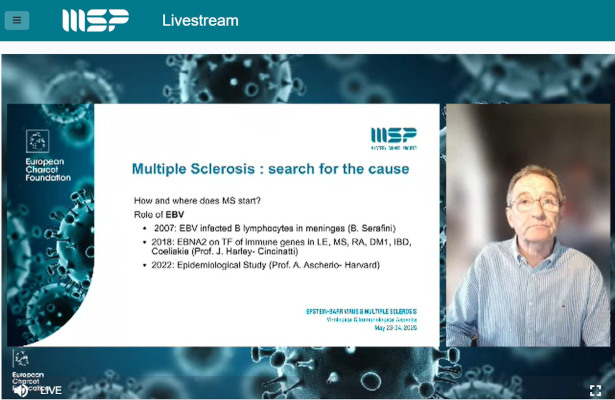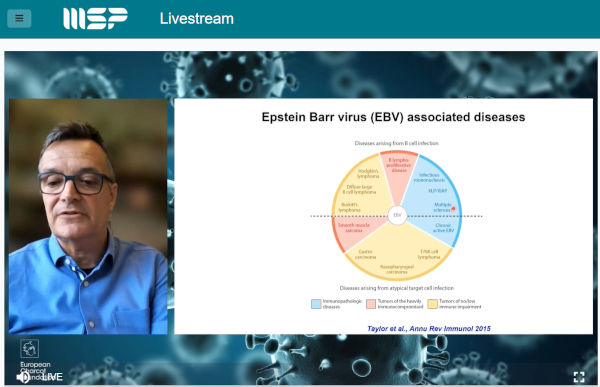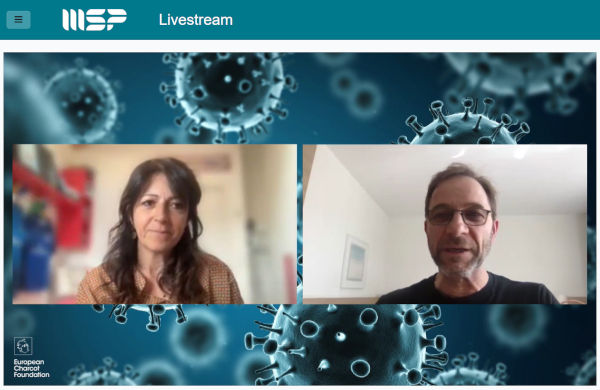Mystery Solved Project 2025
Advancing the Understanding of EBV and MS
Posted on May 26, 2025 • 3 minutes • 589 words
Table of contents
Mystery Solved Project 2025: Advancing the Understanding of EBV and MS
On 23–24 May 2025, the European Charcot Foundation
and the Mystery Solved Project (MSP)
hosted a high-level virtual conference bringing together global experts in multiple sclerosis (MS), Epstein-Barr virus (EBV), and immunology. This landmark event offered a unique platform for interdisciplinary exchange, exploring the complex interplay between viral infection, immune system dysfunction, and neurodegenerative disease.

The Role of Epstein-Barr Virus in Multiple Sclerosis
Recent scientific breakthroughs have increasingly pointed to EBV as a key environmental factor in the development and progression of MS. The virus’s capacity to infect B cells and evade immune surveillance has placed it at the center of neuroimmunological research, particularly for its suspected role in initiating autoimmune processes targeting the central nervous system (CNS).
As Prof. Christian Münz of the University of Zurich explained during the event, “EBV induces CNS homing of B cells that attract inflammatory T cells. This interaction may play a pivotal role in initiating chronic inflammation within the central nervous system, potentially driving the progression of multiple sclerosis.” Participants explored how to translate this growing body of evidence into actionable insights for research, therapeutic development, and prevention strategies. Topics ranged from EBV-infected B cells in the CNS to altered immune responses and pathogenic antibodies. Prof. Jan Lünemann from the University of Münster emphasized the diagnostic and therapeutic implications of these findings: “Elevated antibody titers against EBV are consistently observed in individuals with MS. To explore how these antibodies contribute to disease evolution and progression, we developed an experimental platform for high-resolution analysis of their functional and biophysical properties.”
BEHIND-MS Consortium Contributions
The BEHIND-MS consortium was prominently featured at the conference, with four of its scientific partners presenting new findings and advancing the conversation on EBV and MS:
- Prof. Christian Münz (University of Zurich) presented on altered EBV-specific immune control in MS, examining how disruptions in viral clearance mechanisms or immune tolerance might underlie autoimmune activity in the disease.

- Prof. Roberta Magliozzi (University of Verona) shared recent evidence on the accumulation of EBV-infected B cells in the CNS. She noted, “EBV-latently infected B cells accumulate and persist in the inflamed meninges of progressive multiple sclerosis patients!” Her research suggests these cells could play a critical role in sustaining chronic inflammation and neurodegeneration.
- Prof. Henri-Jacques Delecluse (German Cancer Research Center DKFZ) introduced the BEHIND-MS EU consortium, outlining its goals and collaborative research agenda. He highlighted the biological mechanisms by which EBV may exacerbate MS: “EBV-infected B cells are remarkably effective at disrupting endothelial barriers like the blood–brain barrier. This ability may be key to understanding how the virus contributes to central nervous system inflammation in MS – and could point us toward new therapeutic strategies.”
- Prof. Jan Lünemann (University of Münster) presented findings on pathogenic antibodies against EBV proteins, exploring their potential cross-reactivity with CNS components, further underlining the autoimmune mechanisms potentially triggered by EBV.
These contributions underscore the BEHIND-MS consortium’s leadership in pushing the boundaries of EBV–MS research and its commitment to transforming scientific knowledge into therapeutic innovation.

Looking Ahead
The Mystery Solved Project 2025 conference reaffirmed the critical role of collaborative, cross-disciplinary efforts in tackling one of the most compelling questions in neuroimmunology. As the scientific community continues to unravel the EBV–MS connection, the potential to identify new targets for treatment and prevention becomes increasingly tangible.
The BEHIND-MS consortium remains steadfast in its mission: to advance research that could one day prevent MS or significantly reduce its burden—offering hope for improved care and outcomes for people living with the disease.
